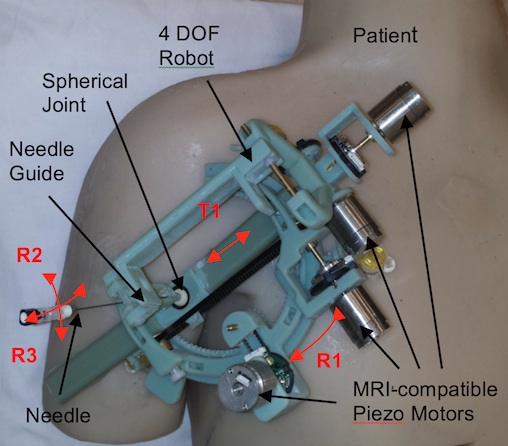
by Kevin Cleary, PhD
Technical Director, Bioengineering Initiative
Sheikh Zayed Institute for Pediatric Surgical Innovation
Children’s National Health System
Washington DC
Interventional procedures are becoming increasingly popular as they minimize recovery time for the patient. These procedures are often done using x-ray imaging to visualize the anatomy. However, there are increasing concerns about the potential long-term effects of radiation. Therefore, if procedures could be done using MRI, there would be no radiation dose, which would be better for the patient.
In pediatrics, concerns about x-ray dose are heightened and therefore efforts are made to minimize dose whenever possible. For example, at our Children’s hospital, we do more MRI exams than CT (at adult hospitals CT exams greatly outnumber MRI exams). Therefore, a Children’s hospital is an ideal setting to develop MRI-compatible robotics to enable MRI-guided procedures.
Patient access in a typical closed-bore MRI scanner can be difficult. Therefore, we have developed a small body mounted robot to enable positioning and orientation of a needle for procedures such as arthrography. As shown in the figure, the robot has 4 degrees of freedom, two for needle tip positioning (T1, R1) and two for needle orientation (R2, R3). The robot is built of plastic parts that were made on a rapid prototyping machine, and is driven by MRI-compatible piezoelectric motors with encoders for measuring angular position.
The initial targeted application is shoulder arthrography, which is used to diagnose joint condition. Currently, arthrography requires two separate stages, contrast injection guided by fluoroscopy followed by an MRI. By using our robot, we aim to simplify this to a one-stage procedure, all done in the MRI room. We can therefore eliminate any ionizing radiation and provide accurate needle guidance in a closed-bore magnet. The long-term goal of our work is to enable routine MRI-guided interventions by creating a platform for other needle-based procedures including biopsy, drainage, nerve, and facet injection.
Personal Note. This is one of several projects in robotics and computer-aided surgery that we are working on at our Children’s hospital in Washington, DC. I moved to Children’s four years ago after spending 13 years at Georgetown University Medical Center which focuses on an adult population. It is very rewarding to work at any hospital towards improved patient care, but particularly at a pediatrics hospital where the focus is children. I would urge all researchers working in this field to partner as closely as possible with medical doctors to ensure that the work we do is clinically relevant.

Leave a Reply